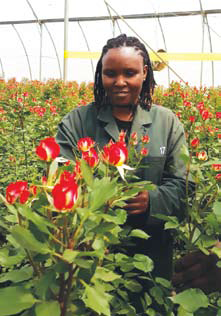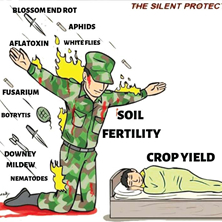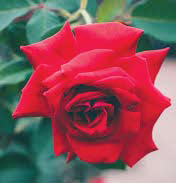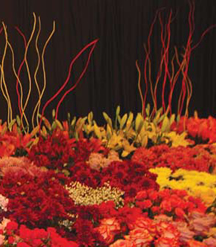Featured Past Articles
For the 8th year in a row, Kenya hosted the International Flower Trade Expo (IFTEX) at the Oshwal Centre, Parklands Nairobi.
 IFTEX which was launched in 2012 has grown tremendously to be a renowned exhibition brand worldwide. Currently it attracts more than 250 both national and international exhibitors ranging from; growers, buyers, breeders, suppliers, regulatory and compliance institutions and logistics. Over time IFTEX has contributed to promotion of Kenyan cut flowers which its demand continues to rise in world market. This action has enabled the Kenyan flowers to compete well with other giants like Ecuador, Colombia and also Ethiopia who are coming up well.
IFTEX which was launched in 2012 has grown tremendously to be a renowned exhibition brand worldwide. Currently it attracts more than 250 both national and international exhibitors ranging from; growers, buyers, breeders, suppliers, regulatory and compliance institutions and logistics. Over time IFTEX has contributed to promotion of Kenyan cut flowers which its demand continues to rise in world market. This action has enabled the Kenyan flowers to compete well with other giants like Ecuador, Colombia and also Ethiopia who are coming up well.
This year’s IFTEX show kicked off on 5th June 2019 with the chairman of HPP international exhibition group inviting exhibitors, buyers and all other participants to the event; “it is with great pleasure to welcome you the 8th edition of Kenya’s trade fair for the floriculture industry, it is without doubt the most important international trade fair for fresh flower trade” said Dick Van Raamsdonk.
The growth of IFTEX over the years has been boosted by its unique approach of reversing the culture of exhibitions across the globe. IFTEX brings buyers and growers under one roof, which makes it so special. “It is a place where you meet buyers and growers together, it is a business platform, international buyers source flowers directly from the Kenyan growers, this makes IFTEX so different “reiterated Dick Van Raamsdonk.
Read more: IFTEX SHOW: Supporting Sustainable Floriculture in Kenya
A great team start with a great leader. This involves setting goals for the team, communicating the mission, setting proper systems and standards and leading by example, Team motivation- Simple recognition of your team’s efforts and celebrating their achievement can go a long way.
 Who is Nancy Kurgat? Describe yourself as concisely as you may.
Who is Nancy Kurgat? Describe yourself as concisely as you may.
Nancy Kurgat is the production and technical manager, Sian Agriflora. She is also a team leader and has over 15 years experience in the floriculture sector. She has a training in Horticulture (Egerton University), Business & strategic management (Moi University) and several in job trainings on supervisory and leadership among others. Over the years, she has grown and progressed through the ranks from supervisory level to management level.
Ladies have a natural affinity for the world of flowers, and show much greater appreciation for it than men do. Even then, very few go about establishing their careers in the flower production industry, like you have done. What spurred you to do so? Any role model or someone who inspired you?
My role model in the industry is Mr Andrew Wambua, the General Manager of Molo River who was my boss when I first joined the industry at Equator flowers. I attribute a lot of my success to the first trainings and mentorship I attained from him. I cannot forget our Chairman Mr. Micah Cheserem whose leadership really inspired and geared me to another level of leadership and creativity. I have not words to express my gratitude other than a big thank you.
In addition, it has been noticed by men of all ages is the affinity of women towards flowers; the freshness, gorgeousness and the innocent blooms have always been a dire favourite of women. Even with this love for flowers women perceived the career as hard for to pursue because of the associated obstacles for instance, growing is tasking and needs a lot of commitment in terms of time. Most women will wish for careers that ensure they are home early and over the weekends to take care of the family.
I joined the industry immediately after I cleared my studies and I must say that I also had the same reservations but after working for some time I realized that I enjoyed more than I thought! I cheered myself that, “YES, I CAN, and will be, a significant part of the floriculture industry in spite of all the obstacles."
A trade show is a big investment of time, money and energy, and you may be asking yourself: is it even worth it? With the rise of digital and online events, YouTube and social sharing, traditional trade shows can feel outdated and inefficient.
However, trade shows are still the one of the best ways to make an impression with a relevant audience. According to the 2017 report from the Content Marketing Institute, 68% of B2B marketers utilize in-person events as part of their marketing strategy, and 36% of them say the events are effective. While trade shows may no longer be top dog for B2B marketers, they are still one of the five most critical tactics for content marketing success and are a major part of many B2B marketing plans.
Get the most out of your trade show by building a comprehensive B2B digital marketing plan to support it.
Read more: How to Use Social Media Before, During and After Your Trade Show
Fertilizers are responsible for over half of global food production, but there are areas in world with nutrient deficiency and other areas of nutrient excess. Managing soil fertility requires careful application of science and skill to meet production, environmental, and social goals. Writes By Dr. Rob Mikkelsen, Ph.D. (Soil Science)
 Getting crops off to a good start is critical for achieving high yields. During this early stage of growth, seedlings are especially vulnerable to many environmental and biological stresses. Protecting plants from stress and disease begins with providing balanced nutrition from planting through harvest. The critical link between plant nutrition and disease resistance has become apparent as the frontiers of plant health are better understood. A few of these examples are explained here:
Getting crops off to a good start is critical for achieving high yields. During this early stage of growth, seedlings are especially vulnerable to many environmental and biological stresses. Protecting plants from stress and disease begins with providing balanced nutrition from planting through harvest. The critical link between plant nutrition and disease resistance has become apparent as the frontiers of plant health are better understood. A few of these examples are explained here:
Potassium
Potassium plays an essential role in many well-recognized metabolic processes for plants. Potassium’s contribution to sustaining high yielding crops with top quality is well understood. However, the role of potassium in plant stress resistance is less known and appreciated. Potassium is unique among the essential mineral nutrients in its role for plant survival against environmental stress, pests, and diseases.
Supplying adequate potassium to crops through proper fertilization is a simple way to lower the requirement for pest-control treatments that may be costly, timeconsuming, and troublesome. The frequently observed benefits of potassium on plant health were reviewed by Wang et al. (2013), which summarizes many recent scientific studies.
Read more: Why Soil Fertility is the #1 Defense Against Crop Pests & Disease
In Drive to Secure International Horticultural Markets Through Management of Quarantine Pests
By KNA
 The Kenya Plant Health Inspectorate Service (KEPHIS) is working with over 200 horticultural produce exporters to the European Union (EU) and Australian markets to formulate strategies to curb False Codling Moth (Thaumatotibia leucotreta) pest which has led to some rejection of the country’s products at international markets.
The Kenya Plant Health Inspectorate Service (KEPHIS) is working with over 200 horticultural produce exporters to the European Union (EU) and Australian markets to formulate strategies to curb False Codling Moth (Thaumatotibia leucotreta) pest which has led to some rejection of the country’s products at international markets.
The Inspectorate’s Managing Director ((MD), Dr. Esther Kimani says the False Codling Moth (FCM) is classified by the EU as a ‘quarantine pest’, meaning farms invaded by the pest are never allowed to sell their agricultural produce to the lucrative market.
“This is a major pest, because the larvae of the moth feed on a wide range of crops such as rose flowers, peppers, cotton, capsicum, macadamia nuts and citrus. The brown insect originated from Sub- Saharan Africa, but has also been detected in Europe and the US. It thrives under warm and humid conditions and can produce up to five generations annually. Although it has been around, FCM in now classified as an emerging pest because it is affecting chilli export from Kenya. The pest has also shifted to rose flowers causing major losses to growers” states Dr. Kimani.
 Overproduction, low demand, high cost of inputs, VAT that isn’t refunded by the government in time, unfavourable exchange rates, volumetric freight costing, high cost of labour and entrance of new players. When talking with the exhibitors at the IFTEX, it’s the combination of these factors that contribute to the challenges that small holder growers are facing.
Overproduction, low demand, high cost of inputs, VAT that isn’t refunded by the government in time, unfavourable exchange rates, volumetric freight costing, high cost of labour and entrance of new players. When talking with the exhibitors at the IFTEX, it’s the combination of these factors that contribute to the challenges that small holder growers are facing.
Over the past two years a lot of acquisitions have been witnessed in the flower sector. This has been heavily attributed to huge cost of operations, shrinking market and freight charges; combining these issues; small-holder growers find themselves in murky waters which forces them to be bought out by the big fish. However, during a one on one interview with the Craig Oulton General Manager, Floriculture (Kisima) he pointed out small-holder growers can still manage to attract revenue and run their farms successfully when they innovate on ways to cut their costs, while practicing socially and environmentally sustainable kind of farming.
How can small-holder growers cut their costs of operations in a bid to maximise their revenue?
There are three areas which takes a lot of money from the growers; inputs, freights charges and labour. The prices of these three entities continue to escalate every year with the market prices remaining constant. This becomes difficult to survive in the industry unless you innovate ways of lowering your expenditures on inputs, freight and labour without compromising the quality of your flowers in return.
Read more: Cutting Cost is Innovation: Success Recipe for Small-Holder Growers
By Bryan Lufkin
 Why does something you could just pluck out of the ground cost so much?
Why does something you could just pluck out of the ground cost so much?
There are several reasons: flowers are delicate, high maintenance, perishable, difficult to grow, often imported and can cross continents as they make their way from field to florist.
So as 12 May approaches – Mother’s Day in nearly 100 countries – you may find yourself grumbling about how much a bouquet costs. But that price tag has to account for the house-of-cards nature of the product: the time and money farmers spend to hit holiday deadlines and the pressure for florists to match supply to demand, or lose out.
Mother’s Day and Valentine’s Day tend to be big flower holidays, pressuring growers and florists to hire extra help - thus bumping up the price tag.
High-risk peaks
Perfect blooms are extremely fragile – both physically and from a business perspective. And when it comes to flowers grown to hit holiday peaks, both farmers and florists face higher labour costs and financial risks. A big driver behind this is the fact that so many countries import their flowers.


